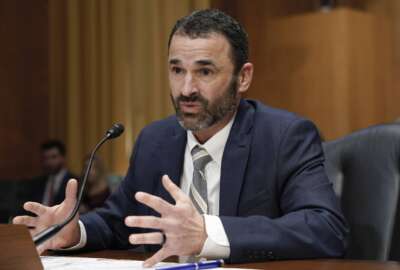Hubbard Radio Washington DC, LLC. All rights reserved. This website is not intended for users located within the European Economic Area.
On Air: Federal News Network
Trending:
FDIC, Surface Board rely on communication to take top spots on ‘Best Places to Work’ list
Top ranked agencies say constant contact with employees is key to success. FDIC moved from the bottom in 2005 to the top this year. Surface Transportation Board...
wfedstaff | June 4, 2015 2:06 pm
The Federal Deposit Insurance Corporation completed a 180-degree change in the satisfaction of its employees.
Over the last six years, the FDIC went from worst to first in the Partnership for Public Service’s Best Places to Work annual survey and rankings.
“We were surprised and thrilled, frankly,” said Martin Gruenberg, the acting chairman of the FDIC after the awards ceremony in Washington Wednesday. “It’s a wonderful recognition and I think what makes it special in a sense is it’s the employees recognizing themselves for the outstanding work they do and the commitment they bring to the very important public mission of the FDIC.”
FDIC jumped two spaces to capture the top spot from the Nuclear Regulatory Commission in the 2011 list, released Wednesday. It also was the most improved large agency, increasing its overall ranking by 5.8 percent.
NRC finished second overall and the Government Accountability Office, the Smithsonian and NASA round out the top five.
In the small agency category, for agencies with less than 2,000 employees, the Surface Transportation Board received the top ranking for the second year in a row.
“I think I heard the day before yesterday, and I was on the road in Alabama in my hotel room, I was jumping up and down,” said Daniel Elliott, chairman of the Surface Transportation Board. “It’s not old hat. It’s very exciting.”
Overall across the government, employee satisfaction dropped by 1 percent to 64 percent.
Six-year project
FDIC’s move to No. 1 came after bottoming out in the rankings in 2005.
“There were two factors I’d point to and it was a multi-year effort. The employees of the FDIC understand well the mission of the agency to preserve the security of people’s bank deposits,” Gruenberg said. “We’ve gone through a severe financial crisis and the FDIC has really a history of rising to the occasion.”
He also credited former FDIC chairwoman Sheila Bair, who left the agency in July, for transforming the way the agency works through decisive leadership during a challenging period.
“I think the combination of an agency with a strong sense of commitment and understanding of its mission combined with strong leadership helped to account for the improvements we’ve seen,” Gruenberg said.
One major focus area for the FDIC was communication.
Gruenberg said the agency promotes conversations in both directions, from management about their goals and from employees about how they are achieving those goals.
“We’ve implemented a program called Culture Change that is really focused on these issues of communications from top to bottom and back up, and across divisions,” he said. “It’s really been a major priority for the agency. I think employees at all levels have responded well to it.”
A council made up of management and employees comes up with recommendations for improving communications.
As part of the program, FDIC employees and the chairman hold a conference call quarterly to raise issues and get an immediate response. Gruenberg said the call has been effective in addressing concerns.
The FDIC also gives employees a “suggestion box” on its website to help further discussion on improvements.
“What’s really satisfying is you can hear directly from employees,” Gruenberg said. “You hear everything from the profound to the mundane in terms of the questions that you hear, but it gives you a direct feel for what’s on employees mind and a direct connection and ability to communicate and there is enormous value in that.”
Regular meetings with employees
Elliott, from the Surface Transportation Board, attributes their success to many of the same reasons as FDIC improved.
He said communication happens all the time. Elliott meets regularly with employees as a group and individually.
“When extremely difficult things happen like government shutdowns and things of that nature, we had an agency meeting just to discuss what would happen in the event of those circumstances coming about,” he said. “Also, I try to manage by walking through the agency a lot. I try to pop in and say ‘Hi,’ I think people enjoy that.”
Elliott said he also holds open office hours at certain times during the day for employees to talk to him.
“We also did a separate survey of our employees and tried to build off of that,” he said.
Elliott said to stay on top, the board already is figuring out where it can improve.
“We will review the Partnership’s numbers. We’ve already started to look at them,” he said. “There is a committee that has been formed to see areas we can improve in.”
FDIC, the Surface Transportation Board and the other top five agencies have other best practices in common as well.
Max Stier, the president and CEO of the Partnership, said there are three things that drive successful agencies:
- Executive leadership
- Skills and mission match
- Pay
Stier said pay rose in importance this year for employee satisfaction, but executive leadership remains the biggest factor in content workers.
The Partnership broke down the leadership category into four subareas: first line supervisors, environment of fairness the leadership creates, senior leadership team and sense of empowerment employees feel from the senior leaders.
“Amongst these four subcategories, the senior leadership piece is most important,” he said. “This was counter-intuitive to us because (we) expected the supervisors would be the most dominate influence among the leadership group for employees. But it turns out that senior leadership group is critical.”
Elliott said agencies who are struggling with employee satisfaction should create an environment of openness and make sure employees have a connection to the senior leaders at all levels.
Stier added the agencies at the bottom of the rankings need to look at the rankings as an opportunity to create a new culture.
The bottom ranked large agencies included the National Archives and Records Administration, the departments of Housing and Urban Development, Homeland Security and Education, and the Agency for International Development.
“I recognize that this is an extremely difficult year for employees at the National Archives, Archivist David Ferriero said in an email statement. We are not only facing federal budget cuts which will impact all of us, but we are undergoing a major transformation that is changing the culture of the agency. While I am disappointed in the results, I am not discouraged. I have spent the last year traveling to our facilities nationwide to listen and learn from our employees. I have heard their concerns and understand their discontent. Based on these conversations, we are making changes to improve morale in four areas: communication, leadership, diversity, and training and development. These changes take time and hard work — my executives and I are committed to turning this situation around and to fostering a better work environment for all employees.”
A HUD spokesman said in an email, “We have to start somewhere and we see this as the beginning of our ascent. We’re committed to doing whatever it takes to move to the top of the list. It’ll take time but we’re moving in the right direction.”
At the event Stier said agencies have responded well to the survey.
“The archivist at NARA has grasped the nettle and is taking on the challenge of creating a vibrant culture,” Stiet said. “He can see what the FDIC managed to do, and know it’s possible. Those kinds of investments are necessary but it does take time.”
RELATED STORIES:
Survey names best places to work in federal government
Highlights of 2011 ‘Best Places to Work’ agencies
Maintaining employee morale in time of federal austerity
Employee tips led to ‘most improved’ agency
Copyright © 2024 Federal News Network. All rights reserved. This website is not intended for users located within the European Economic Area.
Jason Miller
Jason Miller is executive editor of Federal News Network and directs news coverage on the people, policy and programs of the federal government.
Follow @jmillerWFED





